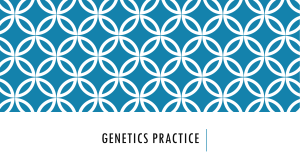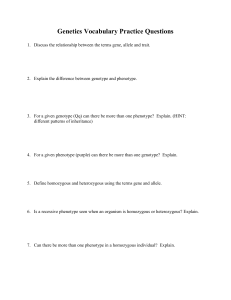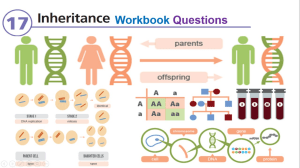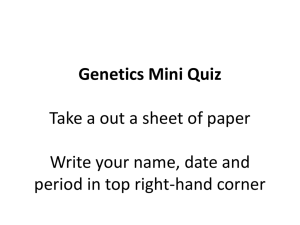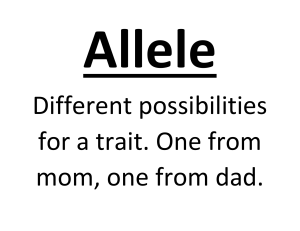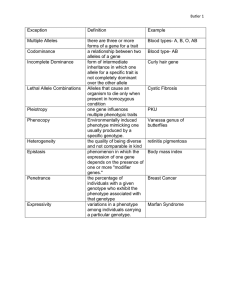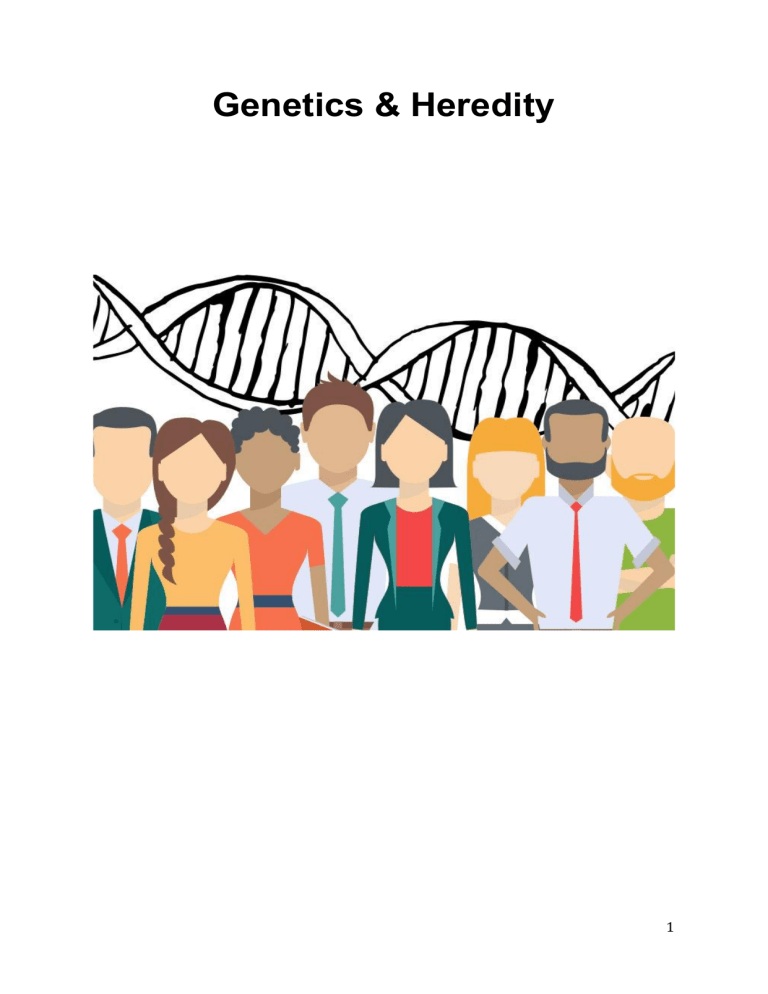
Genetics & Heredity 1 INTRODUCTION Genetics is the science of inheritance and studies the principles of heredity and variation. The hereditary instruction carried within the DNA ensures that offspring resemble their parents and ensures that genetic variation can take place, resulting in survival of the fittest. Genetics and sexual reproduction: During sexual reproduction, offspring are produced that resemble the parents. Remember that two haploid gametes are the result of the process of meiosis. The gametes fuse during reproduction and the result is a diploid zygote, containing a double set of chromosomes. One set of the chromosomes came from the male gamete, which contains the DNA from the father. One set of chromosomes came from the female gamete and contains the DNA from the mother. The child therefore contains DNA from both parents. • DEFINITIONS AND IMPORTANT TERMS AND CONCEPTS: Chromatin network: visible as thread-like structures in the nucleus of an inactive cell • Chromosome: a structure made up of two chromatids joined by a centromere that carries the hereditary characteristics within the DNA • Gene: a unit of sequenced pieces of DNA that carry the genetic information that will determine the hereditary characteristics of an organism. • Allele: one of two contrasting forms of a gene that determine alternative characteristics in inheritance because they are situated in the same position or locus on homologous chromosomes • Locus: The exact position or location of a gene on a chromosome. • Genotype: This is the total genetic composition of an organism. It is the information present in the gene alleles, for example BB, Bb or bb. • Phenotype: This is the external, physical appearance of an organism. The phenotype is determined by the genotype. (phenotype, when both recessive gene alleles are present e.g.: bb) • Dominant allele: an allele that masks or suppresses the expression of the allele partner on the chromosome pair and the dominant characteristic is seen in the homozygous (e.g.: TT) and heterozygous state (e.g.: Tt) in the phenotype. • Recessive allele: an allele that is suppressed when the allele partner is dominant. The recessive trait will only be expressed/seen if both alleles for the trait are homozygous recessive e.g.: tt • Homozygous: when two alleles that control a single trait (on the same locus) are identical. 2 • Heterozygous: when two alleles that control a single trait (on the same locus) are different. • Gene mutation: a change of one or more N- bases in the nuclear DNA of an organism. • Chromosomal aberrations: refers to changes in the normal structure or number of chromosomes. • Genetic variation: this includes a variety of different genes that may differ from maternal and paternal genes resulting in new genotypes and phenotypes. • Multiple alleles: when there are more than two possible alleles for one gene locus. e.g. blood groups • Complete dominance: A genetic cross where the dominant allele masks (blocks) the expression of a recessive allele in the heterozygous condition. • Incomplete/partial dominance: A genetic cross between two phenotypically different parents produce offspring different from both parents but with an intermediate phenotype. Example: Incomplete dominance in flowers: P1 Colour key: R (red) Phenotype: Genotype: Meiosis red RR x white x WW Gametes R ,R, x Fertilisation F1 Genotype: W (white) W, W 4:4 RW Phenotype: 100% pink Example : Incomplete dominance in humans: Curly hair (CC) x Straight hair (SS) = Wavy hair (CS) • Co-dominance: A genetic cross in which both alleles are expressed equally in the phenotype. E.g. Parent with blood group A mates with parent with blood group B and can produce an offspring with blood group AB. 3 Phenotype/Blood type Genotype A IA IA A IA i B IB IB Can receive blood from: A or O B or O B IB i AB IA IB A, B, AB or O (also known as the universal acceptor because blood group AB can accept blood from any other group) O ii O (also known as the universal donor because any blood group can receive O blood) Co-dominance in humans: Homozygous dominant = IA IA (blood group A) Homozygous dominant = IB IB (blood group B) Heterozygous = IA IB (blood group AB) Co-dominance in flowers: Homozygous dominant = RR (red) Homozygous dominant = WW (white) Heterozygous = RW (white with red markings/red with white markings) • Monohybrid cross: when one pair of traits (e.g. colour trait) is crossed to determine the possible inheritance in the offspring. There will always be 4 possible combinations. • Dihybrid cross: the crossing of two pairs of contrasting traits (e.g. colour trait and height) to determine the possible inheritance of the offspring. There will be 16 possible combinations. Dihybrid crosses relate to Mendel’s Law of Independent Assortment. • Filial generation: The first generation of parents (P1) will produce offspring that result from a cross called the first filial generation (F1). The inbreeding of offsprings will produce F2 (second filial generation) EXAMPLES OF MONOHYBRID CROSSES: There are basically FOUR types of crosses. We will use one general trait e.g. hair colour: B = brown hair colour (dominant trait) b = blonde hair colour (recessive trait) 4 CROSS EXAMPLE 1: (Homozygous dominant x Homozygous recessive) P1 (first parent generation) Phenotype: Brown Genotype: BB Meiosis Gametes: B, B Fertilization B B b Bb Bb b Bb Bb x x blonde bb x b, b F1 (first filial generation = first offspring) Genotype: Phenotype: Bb 100% brown CROSS EXAMPLE 2: (Heterozygous x Heterozygous) P1 F1 Phenotype: Genotype: Meiosis Gametes: Fertilization Brown x Brown Bb x Bb B, b x B, b B b B BB Bb b Bb bb Genotype: BB : Bb Bb : bb 1 : 2 : 1 Phenotype: 75% brown and 25% blonde 3 : 1 CROSS EXAMPLE 3: (Homozygous dominant x Heterozygous) P1 F1 Phenotype: Genotype: Meiosis Gametes: Fertilization Brown x Brown BB x Bb B , B x B, b B B B BB BB b Bb Bb Genotype: BB BB : Bb Bb 1 : 1 Phenotype: 100% brown 5 CROSS EXAMPLE 4: (Homozygous recessive x Heterozygous) P1 Phenotype: Genotype: Meiosis Gametes: Fertilisation Blonde x bb x Brown Bb b, b B, b b Bb bb B b F1 Genotype: Phenotype: x b Bb bb Bb Bb : bb bb 1 : 1 50% brown and 50% blonde 1 : 1 HOW TO TACKLE ANSWERING PEDIGREE DIAGRAM QUESTIONS Generation 1 2 3 A E G F J K M L N D H I 4 5 C B O P Female with blonde hair Male with blonde hair Female with brown hair Male with brown hair 6 Analysing the genetic lineage in a pedigree diagram: Step 1: Mark all the homozygous recessive individuals with blonde hair. This will be all the white shapes: E, F, G, I, K, N and P as bb on the pedigree chart. Step 2: Work from the generation line 5 up towards the generation line 1 so that you start with the last offspring on the pedigree diagram. To produce an offspring with bb, BOTH parents must have at least one homozygous recessive gene (b). If the parent is a white shape – then the parent is bb and already marked. If the parent is a shaded shape and produced a bb offspring, then the parent must be heterozygous Bb. Mark the Bb parents on the pedigree diagram. Step 3: Parents that are shaded shapes and produce only shaded shape offspring, can be homozygous BB or heterozygous Bb. Look to the next generation and then work backwards. Mark the parents on the pedigree diagram. Step 4: Answer the questions that relate to the pedigree diagram. Try to work out the genotype of A, B, C, D, H, J, L, M and O on your own first. Let us see if you were right: o A and B are Bb because they produce G (bb) o If C is BB then D must be Bb or C is Bb then D is BB because H must be Bb to produce K (bb) o J is Bb because G is bb and H is Bb (produced sister K - bb) o L and M are both Bb because parent J is Bb and I is bb so they cannot be homozygous BB AND L and M produce a son (N) and daughter (P) that are both homozygous bb o Offspring O can be either BB or Bb because both parents are heterozygous Bb • Karyotype: The number, shape and arrangement of all the chromosomes in a nucleus of a somatic cell. • Sex determination in humans: There are 22 pairs of autosomes and one pair of sex chromosomes (gonosomes) in the human karyotype. Females have XX sex chromosomes while males have XY sex chromosomes. Each time fertilisation occurs, there is a 50% chance of the zygote being male and a 50% chance of the zygote being female, X + X = XX and X + Y = XY. 7 P1 Phenotype: Genotype: Meiosis Gametes: Fertilization male XY x x female XX X , Y x X ,X X X X XX XX Y XY XY F1 Genotype: XX XX : XY XY 1 : 1 50% females : 50% males 1 : 1 Phenotype: • Sex-linked alleles characteristics or traits that are carried on the sex chromosomes. • Haemophilia: A sex-linked condition where blood fails to clot properly. This recessive allele is found only on the X chromosome of the sex chromosomes. INHERITANCE OF HAEMOPHILIA AS AN EXAMPLE OF A SEX – LINKED DISEASE Males have only one X chromosome .The Y chromosome has no gene for blood clotting. This means that the condition of haemophilia is seen in males with only one recessive allele present. A female with one recessive allele will be a carrier because the other X chromosome will carry the normal dominant gene. A female will only be haemophilic if she has both homozygous recessive alleles. EXAMPLES For a normal male and female carrier (heterozygous) cross: P1 Phenotype: Genotype: Meiosis Gametes: Fertilization normal male x female carrier XHY x XHXh XH, Y x XH XH , Xh Y XH XH XH XH Y Xh XH Xh XhY : F1 Genotype: 1 XH XH 1 XH Xh 1 XH Y 1 Xh Y normal female : female carrier : normal male : haemophilic male 25% : 25% : 25% : 25% 8 Phenotype : 50% normal females : 25% normal males : 25% haemophilic males For an affected male and normal female cross: P1 F1 Phenotype: affected male Genotype: Xh Y Meiosis Gametes: Xh , Y Fertilization x x normal female XH XH x X H , XH Xh Y XH XHXh XHY XH XH Xh XHY Genotype: XHXh XHXh XHY XHY 50% of F1 is female carriers : 50% of F1 is normal males 1 : 1 Phenotype : 100% normal The Principles of Heredity: Mendel’s Principle of Segregation: During gametogenesis the two alleles of a gene separate so that each gamete will receive one allele of a gene for a specific characteristic/trait. Mendel’s Law of Dominance When two individuals with contrasting pure breeding characteristics are crossed, the individuals of the first generation (F1) will ALL resemble the parent with the dominant characteristic. P1 Phenotype: Genotype: Meiosis Gametes: Fertilization F1 Genotype: Phenotype: Tall plants x short plants TT x tt T ,T x t , t (principle of segregation) T T t Tt Tt t Tt Tt 100 % Tt (heterozygous tall) 100% Tall (Law of Dominance) 9 Note : that the F1 offspring have characteristics from both parents but in the phenotype, all display the dominant characteristic. The offsprings of the F1 (Tt) grow and mature to become P2. The offsprings of P2 are known as F2. P2 Phenotype: Genotype: Meiosis Gametes: Tall plants T t x x Tall plants T t T,t x T, t Fertilization F2 Genotype: Phenotype: • T t T TT Tt t Tt tt 1 TT : 2 Tt : 1 tt homozygous tall : heterozygous Tall : homozygous short 75% tall : 25% short Mendel’s Law of Independent Assortment Alleles of a gene for one characteristic segregate independently of the alleles of a gene of another characteristic. The alleles for the two different genes will therefore come together randomly during gamete formation. This is also known as random assortment. - - DIHYBRID CROSSES A dihybrid cross involves the inheritance of two characteristics. According to the Law of Independent Assortment, alleles of a gene for one characteristic segregate independently of the alleles of a gene for another characteristic. The alleles for the two genes will therefore come together randomly during gamete formation. This means that the two characteristics are transmitted to the offspring independently of one another. The above law only applies if the genes for the two characteristics are not on the same chromosome. Steps you should follow in working out a dihybrid cross: Example: In hamsters, the allele for black coat colour (B) is dominant over the allele for white coat colour (b). The allele for rough coat (R) is dominant over the allele for smooth coat (r). If you cross a hamster that is heterozygous black and homozygous rough, with one that is heterozygous black and heterozygous rough, what will be the phenotypes and genotypes of the offspring? 10 STEP Step 1 Step 2 Step 3 Step 4 What to do generally Identify the phenotypes of the two hamsters for each of the two characteristics. Choose letters to represent the alleles for the gene responsible for each characteristic. Write the genotypes of each parent. • • • • Step 5 Step 6 Step 7 What to do in this problem According to the statement of the problem, both parents are black and have rough coats. Use the letters, e.g. B for black, b for white, R for rough, and r for smooth as provided in the question. According to the statement of the problem, both parents are heterozygous black, while the one is homozygous rough and the other one heterozygous rough for coat texture. Their genotype will therefore be BbRR and BbRr • The genotype of the parents are: BbRR and BbRr Determine the possible gametes that each parent can produce. Remember that each • If we represent the alleles for each parent will have two alleles gene in the following format, then we for each gene. can see how these alleles could come together randomly (principle of The gametes of each independent assortment) to form the parent will have only one different types of gametes: allele for each gene because of segregation BbRR: BbRr during meiosis. Alleles B b Alleles B b Remember that because of R BR bR R BR bR the principle of independent assortment an R BR bR r Br br allele for one gene could appear in the same gamete with any of the alleles for the other gene. Enter the possible gametes at the top and side of a Punnett square. • Because of random fertilisation, gametes from both parents could fuse in different combinations to form the offspring. • In the punnet square, write down the genotypes of the offspring that will result from each possible combination of gametes Determine the phenotypes of the offspring from the Please refer to the solution that follows. Please refer to the solution that follows. Please refer to the solution that follows. 11 genotypes obtained in the punnet square. Solution to the problem P1 Phenotype Black,Rough x Black, Rough…………………………Step 1 Genotype BbRR x BbRr ……………………………….Step 2,3 Meiosis and Fertilisation Gametes BR Br bR br F1 Genotype Phenotype BR BBRR BBRr BbRR BbRr BR BBRR BBRr BbRR BbRr bR BbRR BbRr bbRR bbRr bR BbRR BbRr bbRR bbRr Steps 4-6 6 different genotypes, as in the table above 12 Black, rough; 4 White, rough………………. ……Step 7 MUTATIONS Sudden change in the genetic composition of an organism. • Gene mutation A gene mutation is a change in the genetic material/DNA sequencing in the cell. • Chromosome mutation/ chromosomal aberration Change in the number or structure of the chromosomes. EFFECTS OF MUTATIONS Mutations assist the organism to adapt to its environment: ➢ HARMFUL MUTATIONS : causes changes in DNA that can cause errors in protein sequencing, that can result in partially or completely nonfunctional proteins. ➢ HARMLESS MUTATIONS : Have no effect on the structure or functioning of the organism. ➢ USEFUL MUTATIONS : Can be advantageous to the organism and they are passed on from parent to offspring. CAUSES OF MUTATIONS - nuclear radiation, exposure to ultra violet light and x-rays ; - viruses; unhealthy diet and alcohol 12 EXAMPLES OF MUTATIONS TO BE STUDIED: Haemophilia, Colourblindness and Down syndrome • Genetic Engineering: the process where scientists alter, swap or manipulate the genes on the DNA, to produce an organism with desirable characteristics. Advantages of Genetic engineering Disadvantages of Genetic engineering • • • • Production of medication/ resources cheaply Control pests with specific genes inserted into a crop Uses specific genes to increase crop yields/ food security Selecting genes to increase shelflife of plant products • • • • Expensive/ research money could be used for other needs Interfering with nature or immoral Potential health impacts Unsure of long term effects Not in Exam guideline. Examples of genetic engineering to be studied: Cloning, stem cell research and genetically modified organisms. ➢ Cloning Process by which genetically identical organisms are produced using biotechnology. Process: • With cloning, the nucleus of a somatic cell (2n) of one organism is removed. • An ovum (n) is taken from an ovary of another organism. • The nucleus of the ovum is destroyed. • The somatic cell’s nucleus (2n) is then placed inside the ovum. • The ovum is put back into a uterus where it is allowed to grow and differentiate into an embryo. • When the new offspring is produced, it is identical to the original organism. • A sheep called Dolly was cloned successfully in 1997. 13 ➢ Stem Cell research: A stem cell is any cell in the body that can differentiate into any specialised type of tissue in the body. SOURCES OF STEM CELLS Stem cells can be harvested from: • • • umbilical cord blood (once a baby has been born), a foetal blastocyst and bone marrow. USES OF STEM CELL THERAPY To treat: • cancers like Leukemia • degenerative diseases like Multiple Sclerosis • diabetes mellitus where the pancreas no longer produces insulin • muscle damage • organ damage and • certain genetic diseases in conjunction with gene therapy 14 ➢ Genetically modified organisms PROCESS Benefits of genetic modification e.g. The Advantages of Genetically Modified Crops • Better for the environment Since GMOs require much less chemicals to thrive, the impact on the environment is lessened. The pesticides and other chemicals commonly used on non GMO crops emit greenhouse gases and pollute the ground soil. • Resistance to disease One of the modifications made to the crops is an added resistance to disease that would normally kill off the crops. This keeps the yields high and the prices for the consumers low. • Sustainability GMOs provide a stable and efficient way to sustain enough crops to feed the 15 ever growing population of people in the world. This was the main goal of GMO crops in the first place. • Increased flavour and nutrition Along with resistances to insects and disease, the genes of the crops can also be altered to have a better flavor and increased nutritional value. This is good all around. • Longer shelf life Genetically modified foods have a longer shelf life. This improves how long they last and stay fresh during transportation and storage. • Keeps it affordable One of the biggest effects that the use of GMOs has had on our everyday life is the prices of produce and other foods. Since more crops can be yielded, the prices can be much lower. PATERNITY TESTING An analysis, usually of the DNA or blood type of a mother, child, and putative father, to estimate the probability that the man is the biological father of the child. Blood grouping - Genotypes of the mother and the suspected man's blood groups are compared with those of the child - If the genotypes for the blood groups of the man and the mother could not lead to the blood group of the child the man is not the father of the child - If the genotypes for the blood groups of the man and the mother could lead to the blood group of the child it cannot be said with certainty that the man is the father of the child because other males have the same blood group. DNA profiles - Every person except identical twins has her/his own unique DNA profile. - It can be described as an arrangement of black bars representing DNA - fragments of the person. - It is used to: • Identify paternity 16 17
